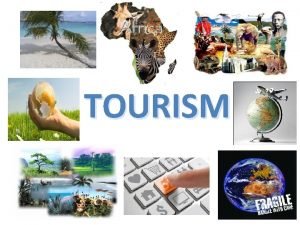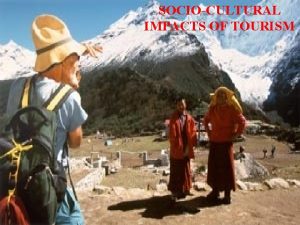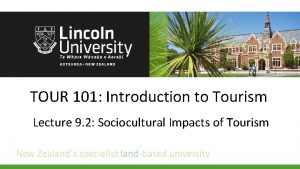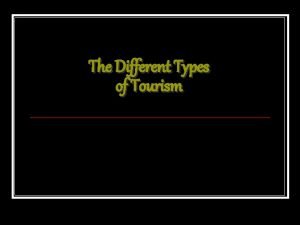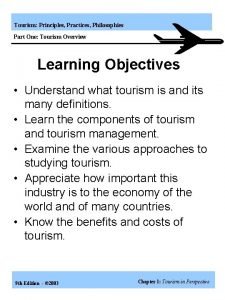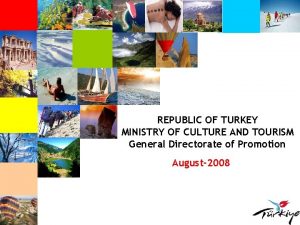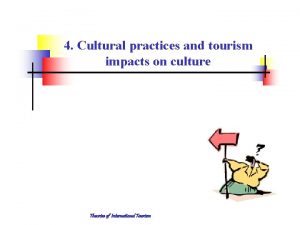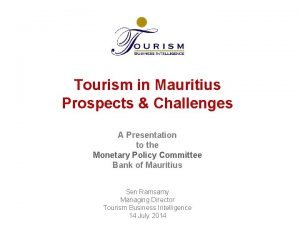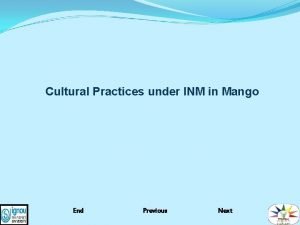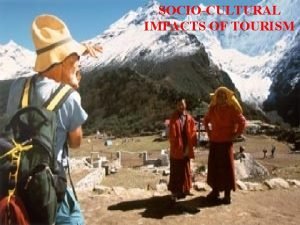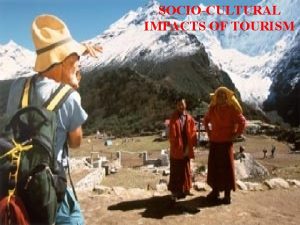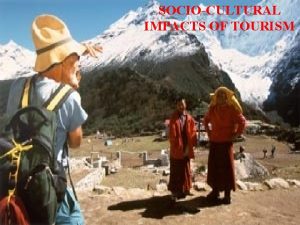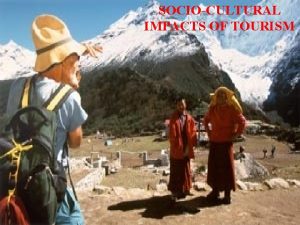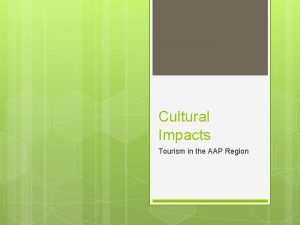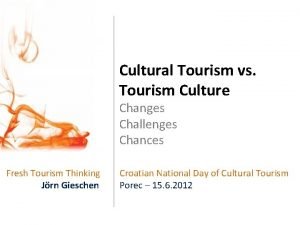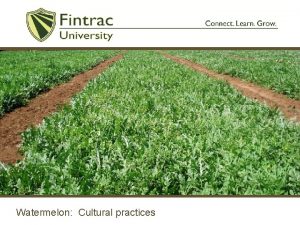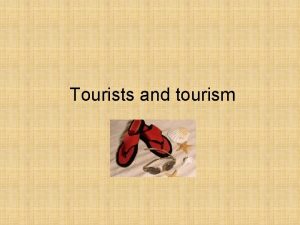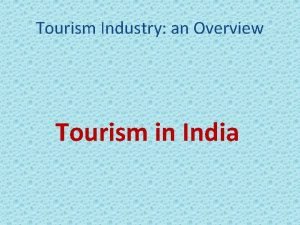4 Cultural practices and tourism impacts on culture





















- Slides: 21

4. Cultural practices and tourism impacts on culture Theories of International Tourism

0. Objectives After completing this chapter you should be able to: • Explain the impact of tourism on culture. • Explain worldwide cultural theories and practices related to culture change. Theories of International tourism

Introduction The results of numerous empirical studies show that many countries and destinations experience cultural changes due to tourism development. The larger the numbers of tourists the more significant are the changes. Theories of International tourism

1. Erosion of local cultures It is often argued that with an increase in international travel and excessive demand for tourism products many societies experience erosion of local cultures and traditional ways of life and customs, including indigenous cultures. As a result, the quality of the traditional artistic designs and forms deteriorates and their artistic and symbolic values and meanings disappear. The traditional art forms become substituted for meanings pseudo-traditional arts promoted for the purpose of sale. Theories of International tourism

2. Cultural commoditization and transformation The local culture is commercially exploited and the rights of locals to own cultural heritage are lost. Examples abound of mass produced and distributed “local” souvenirs or artifacts that can be found in various regions and countries, and that bear little resemblance to original and local artwork. Theories of International tourism

3. Cultural hostility Since tourism often destroys traditional ways of life and local economies, creates dependency and lowskilled unsecured jobs, and harms indigenous people, local hosts develop hostility to tourists. The larger the number of tourists visiting the destination, the greater the hosts’ hostility towards tourists. Theories of International tourism

4. Cultural arrogance Displaying superficial local traditions and customs to tourists is a form of cultural arrogance. However, this is done to protect and insulate local culture from the impact of mass tourism. Theories of International tourism

5. Authenticity of tourism experiences In order to satisfy mass tourism, pseudo-artifacts are produced and commoditized creating standardized and inauthentic products. Most tourists accept commercialized objects as authentic as long as they are convinced that these objects have traditional designs and have been made by members of an ethnic group. Theories of International tourism

6. Renaissance of traditional art forms In some cases tourism enables a rejuvenation of particular forms of art and craft. For example, refining highly demanded Indian and Aboriginal arts and crafts allowed for developing new ideas and creating new designs. Thus, in the process of commoditization (mass) tourism may help to maintain and revive original traditions, and art designs and forms. Theories of International tourism

7. Marketing of culture and violation of rights to own cultural heritage By treating traditional culture as a commodity for sale and making it commercially exploited, culture is turned to paid performance. As a result, the tourists see the visited country through superficial experiences that are selective, pre-arranged, and distorted from reality. The commercialization of culture proves that the traditional culture can be treated as a commodity over which locals lose their rights. Theories of International tourism

8. Culture change occurs as a result of (1) evolutionary changes occurring within a society, (2) changes in the way people live, and (3) contact between societies and groups from different cultures. Visitors bring their ideas to the host country, and hosts expose visitors to their values and perspective. Tourism is a medium for cultural transformation. Theories of International tourism

9. Culture diffusion Cultural diffusion refers to the spread of cultural elements such as ideas, styles, food, religions, technologies, etc. , between individuals and groups within a single culture or from one culture to another. The effect of culture diffusion is changing local cultural features(dressing, styles, food) and traditions; creating new products, services, and jobs; changing beliefs and ideas and improving the quality of life. Theories of International tourism

10. Cultural borrowing occurs when two cultures come into contact and borrow each other’s traditions, customs or values. Borrowing is not symmetrical; it depends on the nature and the duration of the contact, its purpose, context, characteristics of the interacting individuals, and the difference between individuals and their societies. Host destinations that support tourism development borrow cultural elements from tourists’ cultures in order to follow the standards of their culture. Theories of International tourism

11. Cultural drift refers to a temporary and random cultural change. Cultural drift assumes that the hosts’ and tourists’ behavior is changed temporarily for the duration of the tourist stay. The hosts and tourists may return to their original values and lifestyle when tourists leave. Theories of International tourism

12. Acculturation occurs when contact takes place between a stronger culture and a weaker one. Acculturation can be voluntary or forced. The process of acculturation is often referred to as the “Macdonaldization” of global cultures. Homogenized products and global standards that imitate and assimilate patterns of social behavior, language, dress, and, cuisine are spread around the world. This standardization of products around the world blurs cultural lines that results in cultural homogeneity and standardization of tourism destinations. Theories of International tourism

13. Cultural adaption Cultural adaptation refers to adaptation of elements of other culture. Hosts need to adapt some elements of tourist culture in order to meet tourists’ needs. The process of hosts’ adaptation to tourists’ needs often leads to commoditization and commercialization of local culture. Theories of International tourism

14. Cultural adjustment Cultural adaptation is often referred to as cultural adjustment. Trivonovich identified four different stage which every visitor may have to go through when adjusting to a new and different culture: (1) honeymoon stage, (2) hostility stage, (3) integration/acceptance stage, and (4) home stage. Theories of International tourism

15. Culture assimilation There is some ambiguity between the concept of acculturation and cultural assimilation. Acculturation refers to cultural borrowing when some elements of the other culture added without abandoning the native culture. On the other hand, assimilation occurs when a person fully adapts mainstream values of a new culture and gives up his/her cultural heritage. Theories of International tourism

16. Enculturation refers to the learning of what is contained in culture. Thus, enculturation results in behavioral similarities and differences across societies. Enculturation also refers to socialization. Enculturation is sometimes referred to as acculturation, a word which originally referred only to exchanges of cultural features with foreign cultures. Theories of International tourism

17. Demonstration effects is the effect on the behavior of individuals caused by observation of the actions of others and their consequences. The purpose of demonstration is to emulate the success of others. In tourism, demonstration effect refers to local residents adapting the styles and manners of visiting tourists. Young people are particularly susceptible to demonstration effect. Demonstration effect may be responsible for social divisions between the young and old members of a society, and conflicts rather than learning and cooperation. Theories of International tourism

18. Cultural conflicts are created by cultural contacts. Culture affects their relationships, how they develop meanings, create identities, understand their roles and responsibilities, and argue and negotiate. Human conflicts are cultural conflicts. As a result, those who want to avoid conflicts and function more effectively in a new global world will require cultural competency. Theories of International tourism
 Negative social impacts of tourism
Negative social impacts of tourism Negative social impacts of tourism
Negative social impacts of tourism Positive impacts of tourism in scotland
Positive impacts of tourism in scotland Urban hearths
Urban hearths Socio-cultural impacts
Socio-cultural impacts Mass tourism vs alternative tourism
Mass tourism vs alternative tourism Cultural representations and signifying practices
Cultural representations and signifying practices Tourism: principles, practices, philosophies
Tourism: principles, practices, philosophies Republic of turkey ministry of culture and tourism
Republic of turkey ministry of culture and tourism Physical motivators in tourism
Physical motivators in tourism Cultural drift
Cultural drift Cultural tourism in mauritius
Cultural tourism in mauritius Define cultural practices
Define cultural practices Cultural practices
Cultural practices Cultural practices of mango
Cultural practices of mango What is cultural relativism
What is cultural relativism Continuous culture and batch culture
Continuous culture and batch culture Difference between american culture and indian culture
Difference between american culture and indian culture Stab and stroke culture
Stab and stroke culture Folk culture and popular culture venn diagram
Folk culture and popular culture venn diagram Folk culture and popular culture venn diagram
Folk culture and popular culture venn diagram Stab and stroke culture
Stab and stroke culture
